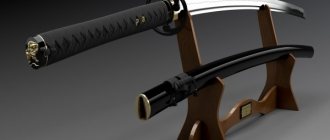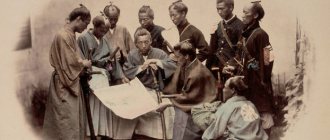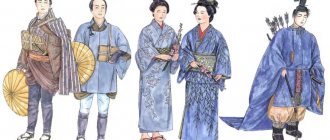Japan is a country where traditions are closely intertwined with the latest technological innovations. Among the skyscrapers, robots and computers, there was a place for numerous martial arts that were formed over the long years of the existence of this country. Meanwhile, while most other martial arts developed punching and kicking techniques, the Japanese paid most attention to wrestling techniques, since punching armor is not the most useful activity on the battlefield. Fortunately, many traditional Japanese martial arts survive to this day. Some are in processed form, while others have come down to us almost the same as they were hundreds of years ago. Of course, traditional techniques are problematic to apply within the framework of a sports match, which has made the development of such arts the preserve of a minority. It is thanks to the efforts of enthusiasts that we can study and practice techniques developed by experienced warriors of ancient Japan.
Japanese sumo wrestling
What do most people associate with the Land of the Rising Sun? Sakura, geisha, samurai and, of course, sumo. This amazing type of wrestling has its origins in ancient times. Although many Japanese researchers find original evidence that wrestling tournaments were held on the territory of what is now Japan more than a thousand years ago, it is impossible to accurately determine the date of the birth of sumo wrestling. Wrestling tournaments have been held since time immemorial and were accompanied by all kinds of rituals and ceremonies. That is, they were more of a religious nature than competitive. Initially, the rules almost did not limit the capabilities of fighters. It was allowed to kick and punch any part of the body, which led to significant injuries.
Only in the Heian era were the rules for conducting a duel drawn up and a clear judging system appeared. Since then, sumo has steadily lost its religious significance and became more and more like a modern sport, which only made it more popular among the masses. However, during the terrible internecine wars that engulfed Japanese lands, this type of fighting was increasingly used by warriors in battles. This is how the division appeared between the military form of sumo and its sports variety. Numerous schools of martial arts, known to this day, later began to branch off from the combat direction.
History of stick fighting
This is perhaps the most ancient type of combat with striking weapons. History knows many schools and techniques of stick fighting, both Eastern and Western, European or Latin American. Here are just a few of them:
Yeomanry - English stick fighting
Yo-menry
- an ancient English martial art, which was intended for combat between an unarmed foot yeoman (peasant) and a heavily armed mounted or foot knight.
The weapon used was rough wood, a pole, about 1.50-1.60 meters long, immediately pulled out of the fence or picked up along the road or in the forest. The upper grip is usually in the middle. Strikes and points are made with both ends of the stick. Philippine stick fighting - Arnis.
Arnis
- Filipino martial art of stick fighting.
Founded in opposition to and using the Spanish (Spaniards - colonizers of the Philippines) school of sword fencing. The maximum length of the stick for concealed carry is 80 cm. The grip is at one end of the stick, but with a slight indentation of about 15-20 cm. The Arnis technique allows you to use this short end for grabs and strikes. These guys are not used to joking - a clan of some McGinleys was dealing with a clan of some McGregors with the help of sticks of all kinds.
Irish stick fighting
- a special fighting technique, passed down through generations from father to son and originating from the ancient “Celtic stick fighting”. This is a whole subculture when Irish family clans feuded with each other for centuries and resolved all disputes in stick fights, which at different times could be fought with extreme cruelty to death, or in the form of a ritual fight, with virtually no injuries. The phenomenon declined after the Great Famine of the late 19th century in Ireland, when that country lost almost half its population. Now Irish stick fighting is developing as a separate martial art. Sticks are used of absolutely any type, with or without thickenings, with or without weights. The length of the stick is from 40 cm to 1 meter. The goal is a fight with an unarmed or armed with a stick opponent.
In Nippon Kempo there is a special section where they study the technique of using the middle stick - tambo.
Japanese stick fighting
There are two legends explaining the origin of the art of using short sticks, which arose as a discipline starting with Hanbo-jutsu. The first says that Lord Kuriyama Ukon, a samurai, participated in the Battle of Nagashino on May 4, 1575 on the side of Oda Nobunaga. In this battle, he met with the enemy general Suzuki Tango-no-kami Katsuhisa, who broke his favorite short spear with his sword. With the remaining stump, Kuriyama fought and defeated the general.
Mr. Kuriyama Ukon broke his spear in the battle, but still emerged victorious
The second legend goes like this. Kuriyama served Lord Maeda Toshiie (前田侯)) in Kanazawa City. One night in the city he encountered robbers and used a long pole (rokushaku bo, length - 6 shaku - 180 cm) in the fight. One of the robbers, their chief Yamada Tenryu Ken, being an experienced warrior of the Kurama-Hachi-Ryu school, had a sword 5 shaku (150 cm) long and in battle cut Kuriyama’s pole in half. However, Kuriyama defeated all the robbers with one stump remaining in his hands (3 shaku - 90 cm). Using this experience, Kuriyama began to develop the art of wielding half of the rokushaku bo (hanbo) and by 1783 introduced it as a full-fledged fighting technique .
We see that the difference in events is almost two centuries, but both legends have their own written evidence. In any case, the truth is that a huge caste of professional warriors - the samurai - spent their entire lives preparing for battle in order to survive and win the battle when the weapons they had were destroyed. And it doesn’t matter what it was - a fragment of a spear, a pole, or something else - what remains in the hands must be brushed aside and won. Therefore, all Japanese disciplines of using a stick, from Bo-jutsu to Yawara-jutsu, are very effective, hard-won, honed techniques and techniques learned from battles. Passed on by us to those samurai who were able to survive using this knowledge.
The discipline of using a stick for self-defense did not stand still. In Japan, where the art of warfare and preparation for battles was brought to perfection and embodied in the science of Bujutsu - 武術, by the beginning of the 20th century, systems and disciplines called Nihon Kobudo, the former name of Kobujutsu, appeared. These methods of self-defense used unconventional types of weapons - that is, weapons used by various segments of the population (heimin), namely peasants, merchants and artisans, warrior monks (yamabushi), police officers (metsuke) and people outside the law (ninja) . All the masters who taught the technique of working with a stick were equally skilled in the field of unarmed martial arts (tode). Essentially, there was no separate training in using a stick without imparting knowledge of self-defense against it. A comprehensive system of self-defense was formed
.
The Japanese have several types of disciplines that study self-defense using sticks of different lengths:
- Bo-jutsu, Bōjutsu (棒術) – the art of fighting with long sticks, the length of which is from 1.80 and above;
- Yo-jutsu Jōjutsu (杖術) - the art of fighting with sticks of medium length from 1.10 to 1.30;
- Hanbo-jutsu, Hanbōjutsu (半棒術) - the art of fighting with sticks with a length of 90 cm to 1.10 cm (literally - half “bo”);
- Tambo, Tambō (短棒術) - the art of wielding a short stick from 20 - 40 cm;
- Yawara Jutsu, Yawara jujutsu (柔術) - the art of using a stick with a length of 14 - 19 cm.
The versatility of the Japanese system of self-defense using sticks of various lengths lies in preparing a person to use any suitable objects for self-defense
Practice Japanese stick fighting
The variety of application and use of techniques in Japan is due not only to the dependence on distance, but also to the versatility of preparing a person for any surprises and the use of any objects for self-defense, regardless of their size. The stick can be used at all combat distances from the furthest to the clinch. At the same time, the technique of its use in battle changes, but the fundamental principles remain the same. If when fighting at a long distance (Gendo-mai-ai distance of two steps and a lunge, Issoku ittō-no-maai distance of a step or lunge), the main attention is paid to fencing and counter strikes on the enemy’s armed hand, then as you get closer (Chikama - close distance), the role of grabs, disarming, choking and painful holds with a stick, actions with an empty (“live”) hand, kicks and knees increases, up to the transition to wrestling (ne waza).
As you get closer to the enemy, the role of grabs, strangulations and painful holds increases.
By learning the principles of using a stick at various distances, starting with long distance and stick length, moving on to mastering medium-length sticks and gaining skill from working with short sticks, the student adapts the technique for different combat situations.
In addition, the student can use either one stick or two in different hands, the Ryotojutsu technique of fencing with two objects, and also learn to use sticks against various weapons. These are stills from the feature film “The Twilight Samurai,” based on the famous Japanese legend.
It is clear that this is a staged fight, but it very clearly and colorfully shows fencing work at a long distance and a combination of grips and using a stick as a lever at a short distance. When using sticks, various interceptions and juggling are very often used. These methods are used to develop sensitivity when working with weapons and use them to subsequently achieve a real attack.
Stick fighting often begins at long range, with both opponents demonstrating various juggling techniques and attempting to trick their opponents into hitting close targets. However, the combat distance may change frequently and may shorten to the point of fighting. A well-prepared student gains the ability to use the stick in a variety of variations, depending on the situation, and the ability to adapt to different tactical formations and options. Stick fighting can both teach you to defend yourself and teach you how to disarm, incapacitate or destroy the enemy - depending on the current situation. Ultimately, the stick gives a person a “third” hand. With its help, a fighter can increase his “leverage,” and this strengthens not only his striking technique, but also gives an additional advantage when conducting painful controls, throws and choking techniques. The versatility of using a stick is simply enormous. It was not for nothing that all monks and preachers preferred the staff to any other type of weapon.
Where to get a stick in a modern fight?
This is another myth that is very widespread in modern society: in modern life there is nowhere to take a stick. Indeed, a modern city is not a Japanese village with fences from which you can snatch a pole, not an English forest in which a pile of strong dry wood lies under your feet, we do not walk along the city streets with staves and poles. That's all true. But you can:
- keep a stick or an object that can be used as a stick in a place accessible to you: at home, in the garage, in the car, in the office;
- carry with you to dangerous places and at dangerous times, for example, when you are seeing off a girl, or meeting your wife after a night shift, an object that can be used as a stick, for example. This will at worst cause confusion on the part of others, but will not be mistaken for a weapon until you use it;
- as a last resort, take away and use the stick or rubber baton available to the attacker or the nearest guard.
Legal consequences of using and storing a stick
Buy yourself one shovel handle or garden stick.
These are sold cheaply in any hypermarket. Of course, if you carry an Irish stick edged with iron in your car or carry it with you, this will raise a lot of unnecessary questions from the first policeman who stops you. A piece of thick fittings or water pipe wrapped in electrical tape will also arouse unhealthy interest and suspicion of your adequacy. However, an ordinary shovel holder, or even a real hanbo, which is always in your trunk, or standing in the corner of the hallway, will not cause any objections from anyone. This is what is good about a simple stick from the legal side. Even if you used a stick in self-defense, you are unlikely to be charged with using a weapon. A stick is a much less lethal weapon than, for example, a knife or, especially, a pistol. It has a huge stopping effect, but it does not have a criminal reputation in the current legislation of almost all countries of the world. Using a stick to hit any part of the body other than the head and neck can lead to serious injuries (fractures and bruises of internal organs), but not death. In the eyes of judges, a knife is a weapon of attack, a stick is a weapon of self-defense.
A telescopic baton with a stun gun is a dangerous weapon that can easily be used against you
By the way, now you can buy a telescopic stick for self-defense
.
You can also buy a telescopic baton for self-defense
, which has a built-in stun gun. There are models with a built-in flashlight, siren and even a gas canister. However, justifying the use of such weapons will be much more difficult.
Whether you are going to use a hanbo or an telescopic baton for self-defense, you need to train in handling this weapon. An unprepared person runs the risk that a weapon he does not know how to handle will be used against him. So practice, practice, practice.
Translated from Spanish - hand defense, a martial art of the Philippines. In the official language of the Philippines, Tagalog, it is called estocada. Both terms refer to the technique of fighting with one or two sticks in the hands.
There are 4 main options for using sticks:
Solo baston - fighting technique with one stick;
Sinawali is the most famous and widespread technique of working with two identical sticks;
Espada y daga - a technique with two sticks, but of different lengths (imitation of a sword and dagger);
Arnis kavayan is a technique of working with a long pole.
Weapon Making
The sticks are made from palm wood or bamboo. The length of the sticks is 70-80 cm, the diameter is 2.5-3 cm, the ends are blunt. They are called baston or mouton. Short sticks imitating a dagger (dagu) 30-40 cm long. The pole is equal in length to two bastons
Fighting technique and training, modern arnis
Arnis teaches self-defense, which boils down to first striking the joints of the enemy’s armed hand, and only then hitting the head or body.
Education
The training is divided into 3 stages, similar to the stages of karate training (Kihon, Kihon-kumite and Ju-kumite).
Stage one
It's called Muestracion or Padalag. At this stage, the correct grip of the stick is studied (it should be held so that it protrudes 8-10 cm from the side of the fist, this so-called protrusion is used for gripping and for delivering unexpected blows at a short distance), five basic blows, various methods of protection from them. Great attention is paid to developing movement techniques. To do this, adherents walk for quite a long time on planks that form triangles with sides of 38-40 cm. This is how they develop a system of leaving the line of attack, as well as a series of blows and blocks with one stick. Then they study the technique of defense and attack with two sticks at the same time.
Stage two
It is called Sanga at pa-tama, or Sombra tobacco. At this stage they begin to work in pairs. They conduct training battles, during which they work on standard combinations and combinations. The student’s task at this stage is not to hit the enemy with a stick, but to correctly master combinations of blows. The speed and complexity are gradually increasing.
Stage three
Larga muton or Labunag totokhanan is a free practice fight, during which the adept practices his own fighting style. Tries to achieve maximum speed of action with both one and two sticks. In free combat, you are allowed to strike anywhere. In addition to blows with sticks, blows with elbows, knees, feet and head are carried out at a short distance. In the past, protectors were not used in freestyle combat, but in our time, thick arm guards that protect from the wrist to the elbows, and a helmet with a mask on the head are required.
In modern Arnis, competitions are held where the fight is judged by three judges, and the most dangerous techniques and combinations are prohibited. It is prohibited to attack an opponent who has dropped his weapon, to finish off someone who has fallen, to strike the groin and face, and it is prohibited to use elbows, knees, or head. Of course, such a sports fight is divided into rounds.
Styles
Arnis Moderno (modern Arnis)
Founded in 1957 by master Remy Amador Presas. He trained under his father, Leon Presas, then under Rodolfo Moncal, then under Timoteo Maranga and finally under Venancio Bacon. He rethought, developed and combined their techniques. Now it has a variety of strikes with an open hand, fist, foot, elbow, knee, and plus a fairly extensive throwing technique.
Escrido
Founded by Kakoi Kanet in the late 50s. In this style, only one stick is used (solo baston) with a length of 76.2 cm. K. Kanet supplemented the elements of traditional Arnis with techniques of judo and karate do, hence the suffix do in the name of the style.
The style promoted by Dan Inosanto. A Filipino who has lived in the United States for a long time and is widely known as a friend and student of the legendary Bruce Lee. Inosanto popularizes working with two sticks (sinawali)
Samahang
A style created and developed by a group of Filipinos in Manila. This style focuses on preserving classic Arnis, without any borrowing from other types of martial arts.
Sumo these days
Ancient giant competitions are still popular in Japan today. Today sumo is the Japanese national wrestling, which has become one of the constant symbols of this country. Professional sumo wrestlers, or rikishi, as they are called in the birthplace of this art, are extremely popular, along with show business stars and outstanding athletes. Although in general being a sumo wrestler today is not nearly as prestigious as in the old days, the most famous wrestlers are very rich and have many fans. Often, famous rikishi are popular with women, despite their specific appearance. Simpler wrestlers receive an average salary, by Japanese standards, and are approximately on the same level as ordinary government employees.
Why are sumo wrestlers so huge? The thing is that in today's sumo, like a thousand years ago, there are completely no weight categories, which makes the participation of lightweight athletes inappropriate. Modern fights are held in a special round arena with a diameter of 4.55 m, which is built of clay and covered with a layer of sand. In addition, during the construction of this traditional structure, special rituals are carried out - special offerings are buried in the center of the arena, and just before the tournament, the place is poured with blessed sake to earn the favor of the gods. It is interesting that even today women are not allowed to step on this platform. Tournaments are held once every 2 months in Osaka, Nagoya, Fukuoka and in the capital - Tokyo, which hosts as many as 3 out of 6 such tournaments. As before, rikishi are divided into two camps - East and West. When entering the platform, a special ritual is observed to drive away evil spirits and other evil spirits. The headband that the wrestlers wear is called kesho-mawashi and is an expensive and complex structure that can weigh up to 10 kg. This headband is embroidered with gold and silver and is made only by hand, so it is very expensive. This just shows how important Japanese sumo wrestling is in modern culture.
Kyudo
The fate of kyudo - the art of archery - largely repeats the fate of kendo. Like kendo, it was practiced by ancient warriors, and like kendo, it was forgotten after the Meiji Restoration. In 1949, the All Japan Kyudo Federation was created, and its revival as a popular sport began.
In ancient times, bows of different sizes were used. Modern sports kyudo uses a standard Japanese composite bow made of wood and bamboo, 2.21 m long. Targets are placed at a distance of 22 or 60 m. In addition to accuracy, the gracefulness of the archer's movements is also assessed. Therefore, kyudo is a popular women's sport and part of the school physical education program.
Yabusame, already mentioned above, is currently not a sport, but a type of show that takes place during various holiday celebrations.
The life of a sumo wrestler
Sumo wrestling clubs recruit young men between the ages of 10 and 15, giving preference to strongly built recruits. A newcomer, entering the club of this unusual wrestling, has no rights, but acquires a lot of responsibilities. He must cook for the older students, clean and do their laundry. The beginner must follow all instructions instantly and without unnecessary questions. Such military discipline may scare off the insecure adept, but those who stay and go through such a school will become excellent fighters, and perhaps one of them will even receive the coveted title of absolute champion or yokozuna. Oddly enough, future rikishi come to this sport as ordinary young men, and acquire incredible size thanks to a special daily regimen and constant training.
Sumo wrestlers rise at dawn. After all the necessary procedures, they immediately go to many hours of grueling training. This Japanese wrestling requires complete dedication. This is the only way to withstand a 4-5 hour workout. After this, the wrestlers take a bath and go to breakfast. The main food at this time is a special stew of meat and vegetables - chanko. It is cooked in a cauldron over low heat and the recipe for this dish is familiar to every rikishi, since they are the ones who take turns preparing the food. After eating, sumo wrestlers go to sleep for 2-3 hours in order to convert food into fat as efficiently as possible. This is followed by evening training and dinner. Sumo wrestlers eat only twice a day, but a lot. They are also not limited in the consumption of alcoholic beverages, that is, drinking sake or beer at dinner is not considered something bad among sumo wrestlers.
Jujutsu
The exact opposite of sumo is the Japanese wrestling jiu-jitsu, or jujutsu. In it, in contrast to the forceful methods of combat typical of sumo wrestlers, the emphasis is on skills that provide the fighter with victory over a stronger opponent. The technique of jujutsu was formed under the influence of numerous internecine wars, which are so rich in Japanese history. Therefore, this Japanese wrestling is filled with completely inhumane fighting techniques. Jiu-Jitsu has a lot of twists and holds designed to break a limb or choke an opponent. Also, in this martial art, vital points on the enemy’s body are actively affected, which makes it impossible to hold full-fledged competitions in this type of wrestling.
This unique Japanese art is more traditional than other types of Japanese wrestling. Many jujutsu techniques seem too complex and impractical to modern people. However, you need to understand that this art was created for warfare, where various types of bladed weapons were widely used. Most jiu-jitsu techniques are aimed at disarming an opponent or getting into a position from which it is more convenient to use one's own weapon. The principles on which this struggle is built are interesting. Jiu-Jitsu masters use the opponent's strength against him, preferring not to get involved in a straightforward confrontation. This art makes full use of knowledge of biomechanics and leverage, which makes the jujutsu master a dangerous opponent for any fighter.
Judo
The creator of this interesting type of wrestling is Jigaro Kano, a man who decided to select the best techniques and principles from jiu-jitsu in order to synthesize a more applied, modern art. If jujutsu is translated as the art of gentleness, then judo is translated as “the gentle way.” This martial arts, like many other types of Japanese wrestling, the names of which you will find in this article, professes overcoming strength with gentleness. Techniques selected from the ancient military system were adapted to suit this principle. There are no punches or kicks in this martial arts, and the most dangerous techniques have been excluded. Therefore, in this type of Japanese wrestling there are competitions, which has a positive effect on the preparedness of athletes.
Judo matches take place on tatami - elastic mats made of modern materials or, as it was before, made of compressed straw. The wrestlers wear heavy-duty jackets, which seriously increase the importance of a good hold, and also engage in some chokes. This Japanese wrestling is distinguished by beautiful amplitude throws and limited actions on the ground. A judo master can easily feel the opponent's center of gravity and feel the vector along which his effort is directed, which allows him to throw using the opponent's strength. This fight has gained worldwide fame. Judo is practiced all over the globe and its popularity is only growing. It is not surprising that this wrestling is included in the program of the Olympic Games.
Brazilian Jiu-Jitsu
One judo and jiu-jitsu master moved to Brazil, which gave birth to an interesting style of wrestling that has become incredibly popular in recent years. His name was Mitsuyo Maeda, and it was he who taught his art to Carlson Gracie, the first member of the legendary family who laid the foundations of Brazilian jiu-jitsu. Despite the fact that the Brazilians initially studied judo and jujutsu techniques, what they achieved was no longer Japanese wrestling. The martial arts of the Gracie family were distinguished by a wealth of techniques aimed at conducting a fight from a supine position. This unique style of fighting developed because some members of this wrestling family were of rather fragile build. Thanks to the competent use of leverage and structural features of the human body, they could defeat fighters much heavier and larger than themselves.
The art of the Gracie family gained the greatest popularity thanks to their fights with representatives of other martial arts, from which masters of Brazilian jiu-jitsu most often emerged victorious. They proved that mysterious masters who can kill a person with one blow are just a fiction. One after another, the martial arts masters who were considered the strongest in those days surrendered. These fights between representatives of various martial arts marked the beginning of the now popular MMA, where adherents of Brazilian jiu-jitsu feel like fish in water.
Aikido
This Japanese wrestling was created by an extraordinary person - Morihei Ueshiba, who was nicknamed O-sensei, which means “great master”. He sought to create an art that gives students not only combat skills, but also teaches them to control their life energy. We can safely say that Aikido trains not only the body, but also the human mind.
A master of this martial art is able to neutralize the enemy without causing him serious damage, something that masters from other martial arts cannot boast of. In this wrestling, as in judo, the emphasis is on redirecting someone else's strength rather than using one's own. Aikido philosophy prohibits the use of this art for the purpose of attack, and indeed does not encourage violence in any form. Therefore, in this type of wrestling there are no attacking techniques; all techniques are exclusively defensive in nature.
Kudo
Kudo is a modern type of Japanese martial arts, invented and finally presented in 1981. The uniqueness of martial arts lies in the combination of striking techniques of Thai boxing, some karate techniques and some other types of wrestling. Full contact combat is quite tough, so the competition is dynamic - only 3 minutes are given for one fight.
For protection, the fighters wear gloves, as well as a specially designed helmet. In addition, due to the officially sanctioned groin strike in equal weight classes, appropriate protection is required.
Naginatajutsu
Add to Anti-Banner
Eskrima De Campo JDC-IO
is a Filipino martial art that belongs to the long-range eskrima styles. The acronym JDC-IO consists of the first letters of the name of the founder of martial arts, Jose D. Caballero, and his first student, Irineo Olavides. The first name of the school was De Campo Uno-Dos-Tres Orihinal. The students then named the school Eskrima de Campo JDC-IO for the merits of Eric Olavides, who improved the Caballero GM system.
This style mainly applies long range. Masters of the style consider it most correct to fight at a long distance, using a stick. And at close range and in the clinch, it is more useful to use a knife, fists, head strikes, etc. In Eskrima De Campo, direct attacks are carried out, as well as strikes at striking distance, instead of striking in the corners, which is used in most close combat systems.
Eskrima De Campo does not use stick-to-stick blocks and does not develop unarmed fighting techniques.
Disarms in this style are performed by striking the weapon hand. When training in this style, much attention is paid to developing strength, accuracy and speed. Training to practice an accurate strike is always carried out in instructor-student pairs. Exercises that are carried out between a pair of equal fighters are not encouraged, because a fighter must always be able to take on a superior opponent, not just street thugs. Grandmaster Jose Caballero had to beat not only ordinary thugs, but also the best fighters fighting at that time: Balbino Manchao, Simeon Saavedra, Vincent Labor, Juan Carolla, Generoso Carbajos, Alfredo Macalolan, Tanchong Lopez, Jorge Navajo, Solomon Canonio, Pastor Jingoyo, Anoya of Tangub et al. Although this system is quite brutal, it focuses the students' attention on hitting the weapon hand to reduce the chances of a fatal fight. Caballero never seriously injured or killed his opponents.
Video: Stick fight in slow motion
Kendo
Of course, when talking about Japan, we must not forget about such an important attribute of a samurai as the samurai sword. Japanese sword fighting is called kendo and has its roots in ancient times, when the life of a person and his family could depend on the ability to wield a sword. Fencing techniques have been honed for thousands of years, during which sword masters constantly fought in bloody wars. It depended on the warrior's technique whether he could survive the battle. Therefore, you can hardly find useless or difficult movements in kendo. Simplicity and effectiveness are what have allowed this martial art to survive to this day.
Previously, during fencing training, students practiced their skills mainly on projectiles and trees, since real sparring was very dangerous. Even training matches were then carried out with real weapons, which led to extremely high injuries. Nowadays, special bamboo swords and durable protection are used. This allows training matches to be held without worrying about the health of the athletes. However, this is not just Japanese stick fighting; all kendo techniques can be applied with the samurai sword. Without a doubt, this spectacular art will develop and spread throughout the world.
Hard and soft methods of using force
There are two main strategic methodologies for the use of force in Japanese martial arts . One of them is the hard method (goho) , the other is the soft method (柔法 juho) . These two concepts are distinct but interrelated in nature, in accordance with their philosophical relationship to the Chinese principles of yin and yang.
The hard method is characterized by the direct use of counter-force. In practice, this can be a direct attack, consisting of a move directly towards the opponent, combined with a strike towards the opponent. A defensive technique where the defender stands still to block or parry (resisting to prevent an attack) would be an example of a hard defensive technique. The hard method technique is generally understood as linear. It’s the same as making clear attacks without fear or reproach.
The soft method is characterized by the indirect use of force, which either avoids an attack or redirects the enemy's forces. For example, taking an attack by "sliding" past the attacker, then applying force to the attacker's limbs to unbalance him is an example of the soft method. The soft method technique is usually understood as circular.
These definitions lead to an often illusory distinction between "hard style" and "soft style" martial arts. In fact, both styles are used in practice, regardless of their specification. Analyzing the differences according to the principles of yin and yang, philosophers argue that the absence of one of the methods will lead to imbalance in the practitioner, just as yin and yang are part of one whole.
Modern Japanese wrestlers
Today, martial arts are still popular in the Land of the Rising Sun. Japanese wrestlers are considered among the best in the world. They participate in competitions according to the rules of MMA, judo, and Brazilian jiu-jitsu. Japanese freestyle wrestling is also well developed. This country was one of the first to see the incredible potential of mixed martial arts. And given the huge number of wrestlers living in Japan, there are always people willing to step into the cage. It is also worth noting the skill of Japanese judokas, who often show incredible results in international competitions. I would like to believe that MMA fights held in this country will make martial arts even more popular among the Japanese, and we will be able to see more skilled fighters from Japan.
Japanese martial arts
The wonderful world of Japanese martial arts has techniques for every taste. For example, Japanese hand-to-hand fighting jujutsu with a huge number of ancient techniques, which is not only a system of self-defense, but also a unique cultural heritage. For those who prefer striking techniques to wrestling, there is karate. And a peace-loving and kind person will find everything he needs in Aikido. This system not only teaches self-defense, but also helps to achieve harmony and spiritual perfection. If you like competitions, then you will like another Japanese wrestling, the name of which is judo. The skills acquired in it will help you stand up for yourself, and a sports lifestyle will bring health and joy into your life. Japanese types of wrestling are popular all over the world. In dozens of countries there are thousands of halls promoting the arts of the Land of the Rising Sun. There is reason to believe that Japanese martial arts will only become more popular over the years. This gives us hope for a bright future.
Anime Amino
▬▬▬▬▬▬▬▬▬▬▬▬▬▬▬▬▬▬▬▬▬▬
“If a person gets up after a fall, it’s not physics, it’s character.”
▬▬▬▬▬▬▬▬▬▬▬▬▬▬▬▬▬▬▬▬▬▬
Good day, dear AA members.
Kylie and the fifth department of the Development Department are in touch. I think many of you know or have at least heard about Japanese martial arts. In this post I would like to tell you about several types of Japanese martial arts and look a little at the history of their origin.
•━━▹ GENERAL
•━━━━━━━▹ INFORMATION
▬▬▬▬▬▬▬▬▬▬▬▬▬▬▬▬▬▬▬▬▬▬
▼
▿
The most famous martial arts (at least those that come to mind first) are karate, judo and aikido. Mostly due to the fact that they are the ones that are put on public display more, so to speak, and they are simply in great demand. Cinema also plays an important role in the promotion of Japanese martial arts. Agree, quite often when watching a movie you can see or hear the characters discussing Japanese martial arts. And if the film is in the action genre, then it is not surprising if one of the heroes knows karate or aikido. In fact, Japanese martial arts attract people not only because they offer to learn how to fight and crush everyone with one blow cooler than the Hulk, but they also literally fascinate with their atmosphere and sophistication. Plus, don’t forget about the huge number of legends associated with samurai. I think this is what drives people to train hard to achieve their goals. What makes Japanese martial arts more tempting are interesting and, for many, unusual terms that you are unlikely to encounter in other types of martial arts. For example, “sensei”, “dojo”, “tatami” and many others. Japan is the birthplace of a huge number of different martial arts, thanks to which a person can expand not only his physical capabilities, but also his spiritual ones.
•━━▹ BUJUTSU
•━━━━━━━▹ GEORGE OF MARTIAL ARTS
▬▬▬▬▬▬▬▬▬▬▬▬▬▬▬▬▬▬▬▬▬▬
▼
▿
Almost a century-old bujutsu is taken as the historical basis of all martial arts: “the art of killing” (not bad :new_moon_with_face: ). In fact, this is quite expected, since it is unlikely that martial arts were invented in order to purify one’s soul and comprehend Zen. Martial art is primarily about combat, in some cases to the death. Naturally, samurai and ninja used bujutsu the most. Since this martial art is quite universal and is used in various forms, it, of course, had a large technical arsenal. Specifically, bujutsu combined striking techniques with hands and feet - it was something like “kiya-kiya”, as many people like to play around with, only once 59 cooler; also a complex of throws, painful techniques (such as hitting only in certain places where the pain is felt much stronger), escapes and grabs, which were used and were very effective if a samurai/ninja confronted an armed man. From this we can conclude that bujutsu is the great-grandmother or great-grandfather of all currently existing Japanese martial arts. The most important goal and, in general, the essence of bujutsu is to effectively defeat the enemy, possibly with a fatal outcome. This is precisely what distinguishes bujutsu from all modern styles, which represent an ordinary victory in a sports match according to established rules. Bujutsu was that type of hand-to-hand combat where all means are good to defeat the enemy.
•━━▹ KARATE
•━━━━━━━▹ A KIND OF JAPANESE MARTIAL ARTS
▬▬▬▬▬▬▬▬▬▬▬▬▬▬▬▬▬▬▬▬▬▬
▼
▿
Karate is one of the most famous martial arts in Japan, literally translated as “empty hand.” Karate and karate-do originated not entirely in Japan, but in Okinawa, when it, in turn, was still an independent state. Karate was based on many types of Chinese martial arts, mainly kung fu and kempo. Karate is a type of self-defense, or, to be precise, a type of it without the use of weapons, where, in fact, striking techniques with hands and feet predominate. In karate there are also throws, but they are used very rarely, and in sports karate they are completely absent. Funakoshi Gichin is considered one of the first masters to introduce karate to Japan. He also founded such a popular style as Shotokan. There is a second version, which says that the Okinawan karate master Motobu Shoki defeated an American boxer in a duel, which is why interest in this, at that time little-known, martial arts from the southern province of Japan arose. At the moment, there are a large number of styles: from sports to applied, from practically non-contact to those where full contact strikes are used without gloves. In particular, many are attracted to the tameshiwari technique - breaking hard objects with hands or feet, as well as kata - educational formal complexes of movements containing encrypted applied techniques.
•━━▹ JUDO
•━━━━━━━▹ A KIND OF JAPANESE MARTIAL ARTS
▬▬▬▬▬▬▬▬▬▬▬▬▬▬▬▬▬▬▬▬▬▬
▼
▿
The second famous type of Japanese martial arts is judo, the name of which means “flexible way.” The founder of this type of wrestling is the master Jigoro Kano, who decided to take another type of martial arts as a basis - jujutsu, naturally changing many details. In particular, he filled his style with a new meaning, relied on technical and spiritual components, and on personal improvement. Judo, like karate, is a form of self-defense without weapons, but, unlike it, judo is dominated by throws, painful holds, holding and choking in a standing position, and there is practically no striking technique. Due to the high technical arsenal, physical strength plays a rather insignificant role in judo, which makes this type of wrestling more accessible to a large number of comers.
•━━▹ AIKIDO
•━━━━━━━▹ KIND OF MARTIAL ARTS
▬▬▬▬▬▬▬▬▬▬▬▬▬▬▬▬▬▬▬▬▬▬
▼
▿
Another equally popular form of Japanese martial arts is Aikido. The hieroglyphs “aiki-do” mean “the path to harmony of spirit”, I don’t know why, but this reassures me. According to one source, this type of martial art was founded by master Morihei Ueshiboy in the twenties of the last century. And unlike other types of martial arts, where the emphasis is on physical strength, in Aikido the most important thing is spiritual improvement and finding inner harmony. In short (and as clearly as possible), in aikido there must be a merger with the opponent, or rather, with his attack, and, as it were, the use of his strength against him. I can't imagine how this works. Aikido is a rather passive form of martial art, the arsenal of which is dominated by waste techniques and many others, thanks to which you can defeat your opponent by dodging blows and then neutralizing him. For women, this type of martial arts is the most suitable and interesting. But you shouldn’t think that aikido is so peaceful, since in the Japanese special services and the Self-Defense Forces it is aikido that is studied as the main form of martial arts.
•━━▹ IAIDO
•━━━━━━━▹ THE ART OF WORKING WITH KATANA
▬▬▬▬▬▬▬▬▬▬▬▬▬▬▬▬▬▬▬▬▬▬
▼
▿
And the last type of martial art that I want to tell you about is Iaido. This is the art of working with edged weapons, and specifically with a katana, a combat sword with a steel blade.
•━━▹ CONCLUSION
•━━━━━━━▹ FAREWELL
▬▬▬▬▬▬▬▬▬▬▬▬▬▬▬▬▬▬▬▬▬▬
▼
▿
One of the most important advantages of Japanese martial arts is that they enrich a person not only physically, but also spiritually, thereby making him more harmonious, balanced and self-confident. Perhaps it is precisely this, constant improvement, not only physical, but primarily spiritual, that lies the highest meaning of practicing Japanese martial arts.
That's all, I hope you learned something new and interesting for yourself.
▬▬▬▬▬▬▬▬▬▬▬▬▬▬▬▬▬
Huge thanks to Kemi for the cover. :hearts:
Uniqueness
#DepartmentofDevelopment #FlockAmino
#ReferenceOtaku
▬▬▬▬▬▬▬▬▬▬▬▬▬▬▬▬▬











